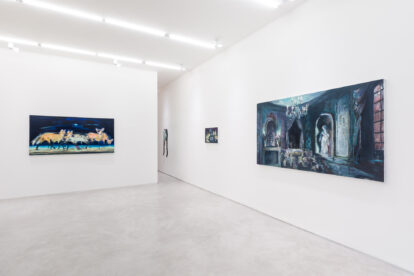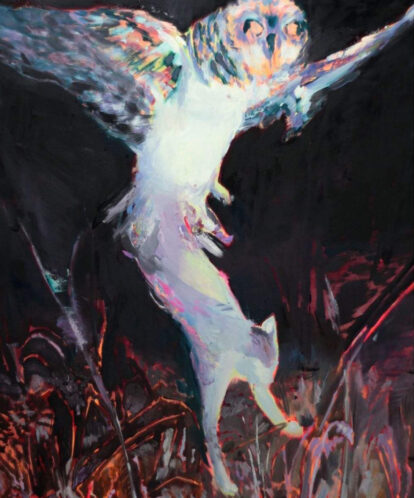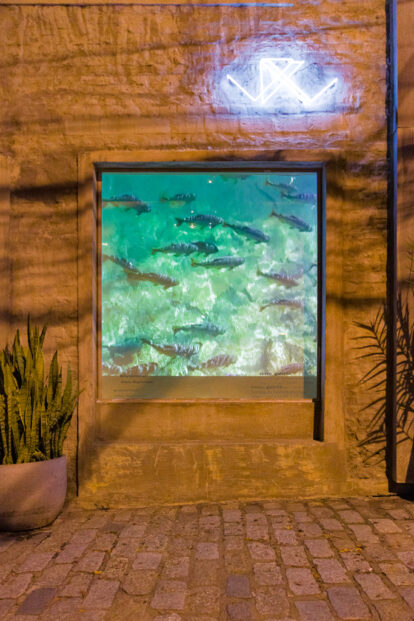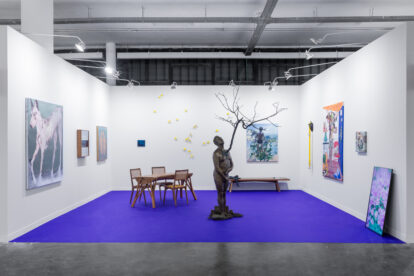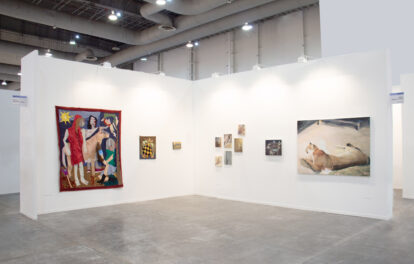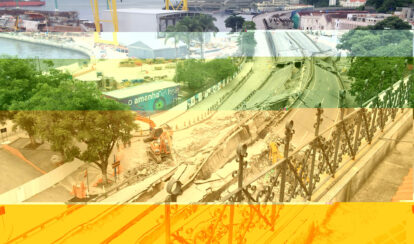“Because everything sings and singing is immense” — Herberto Helder
The artist is not interested in clear images and it is to be assumed that in landscapes taken by the sun, such as the view of the beach or the sea getting lost in the distance, such as islands, sandbanks, mountains and even icebergs, she prefers the oscillating mirages produced by the separation between the invisible masses of cold and hot air, the so-called Fata Morgana effect, which refracts light causing the world to float and dissolve in the distance. Letícia Lopes’ interest leans towards shadows and dreams, towards what is not known for sure. And what are dream images, what is their substance? Coming from what has been seen and experienced, the modality of images coming from dreams, even when crystalline, are always clouded, they are organized in truncated, apparently disconnected chains, dragged as they are by the “incomprehensible wind of destiny”, as the narrator of Breve romance of dreams suggests, a masterpiece by Arthur Schnitzler, the author most respected by Freud – he was not responsible for The Interpretation of Dreams –, source of Eyes Wide Shut, by Stanley Kubrick, all three certainly appreciated by our artist.
A possible proof of this is Fundo [Background], a grand and gloomy canvas (180 x 130 cm), at the lower end of which one can see a person lying down – a woman? It weighs on both figure and mask, the latter being lighter, more identifiable than the former, a dark band like a convulsing sea in the night. Waves of deep blue stretch from side to side, interrupted by fading traces of whites, yellows and purplish reds. Above this band, from an uncertain horizon line, rises a clear blue sky, crossed by pale yellow, within which a solar disk can be glimpsed. The duo – woman and mask – submerged in the deepest plane of the canvas, which is also that of sleep, receives nothing from this elevation. And then think about the title. In this painting and in the others presented – Procession, Interior, etc – to conclude that her interest in changing images extends to words; examines words, weighs them up to the point where they break their commitment to univocal meanings, gain autonomy and flesh, and pass into the sphere of suggestion. They are no longer transparent windows, at least tilting ones, they beckon with profusions of meanings.
Background? After all, what is the artist referring to? To the dominant blue hue of the canvas, sober and withdrawn? And to its protagonism, amplified through thick brushstrokes, freed from a functional treatment? Or to the lower plane of the canvas, on which lie woman and mask? Or is it still what remains dormant in each of us, the most hidden, indeterminate corner, safe even from our will to understand? There is still, and no less important, the sonority, the gravity of the letter u, which gives concavity to the word, leading it, to those who read or speak it, to resonate in even more subterranean extracts. These possibilities, these open paths, are recurrent in her works, resources jealously cultivated by the artist.
Letícia thinks like a poet, as such she is busy extracting words and images from undue servitude, simplifying visions of a complex and mysterious world. I started the text alluding to the Fata Morgana effect and dreams, but as can be seen from a brief examination of the title of one of the works, the matter goes further.
Where do the animals in Procession come from? I immediately thought of a small pack of maned wolves, an animal that is a symbol of Brazilian fauna, with its reddish-yellow fur, its elongated paws elegantly covered in black. Then I noticed the possible presence of hyenas, lending dubiousness to the scene, throwing a naively realistic hypothesis to the ground. What would be a scene taken from one of those delicious documentaries of animal life, suddenly becomes the welding of different scenes, taken from different contexts. Speaking of contexts, where does this water slide where the flock of animals splash their paws come from? The image has something of a dream: we watch a parade – a procession – of animals in the deep night; a small miracle in the form of lives built on quick brushstrokes and contrasting colors, lighting up the darkness, illuminating the liquid floor; a moving and diaphanous veil that somehow goes back to the ancestral surprise of apprehending the wild data circulating around us.
Letícia is a collector of images and objects: “I walk a lot, everywhere and whenever I can. I go anywhere that sells books or obsolete objects (I tolerate that word, but I don’t apply it), antiques, junk (that word I love), from other people, other times.” The reason for this reaction to the obsolete term is understandable: objects do not cease. The memorable Herberto Helder, poet among the artist’s favorites, warns in his poem Don’t touch immediate objects: “A vase with a transparent chrysanthemum / has a hidden tremor”. The artist takes images and objects and brings them together, arranging them with scenographic refinements on printed fabrics like a stage or like a scholar of the Warburg school, less interested in organizations by family and similarities, and more in the formal and symbolic clash of the collected junk.
Each object and image, from a spoon to a tarot card, carries with it a myriad of meanings, in such a way that the superposition, juxtaposition and mutual approximation open unsuspected perspectives, makes immemorial songs resonate. It is a mistake to assume that objects are trivial, even the most common porcelain rabbit, made with the simple purpose of decorating a table, was born from the fascination with nature, from the perception of our reciprocal entanglement with it. Hence the enigmatic series of small canvases where a human figure with open arms always receives the representation of an animal on its back. Nowadays, when tattooing has become a common procedure, it would be worth discussing the mythical-religious foundations of this practice, which in part makes the skin itself the surface on which the values that are intended to be worshiped are presented.
In a time like the one we live in, in which the literality of reality shows and wars have become a major attraction, Letícia Lopes avoids solar arguments, defending mystery and enigma as principles of what actually matters.

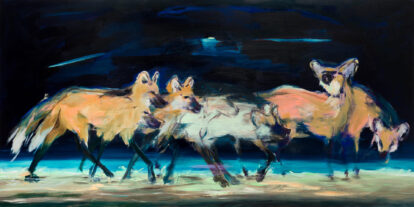
![Pintura para aparição II [Painting for Apparition II]](https://www.vervegaleria.com/wp-content/uploads/2022/05/strauss-200-dpi-768x536.jpg)
![Suspensão [Suspension]](https://www.vervegaleria.com/wp-content/uploads/2022/05/antinatural-300-dpi-768x931.jpg)
![Legitimando o transe [Legitimizing the trance]](https://www.vervegaleria.com/wp-content/uploads/2022/05/legitimando-o-transe-768x924.jpg)
![Banquetinho [Little feast]](https://www.vervegaleria.com/wp-content/uploads/2022/05/220217_verve_048-copy-768x512.jpg)
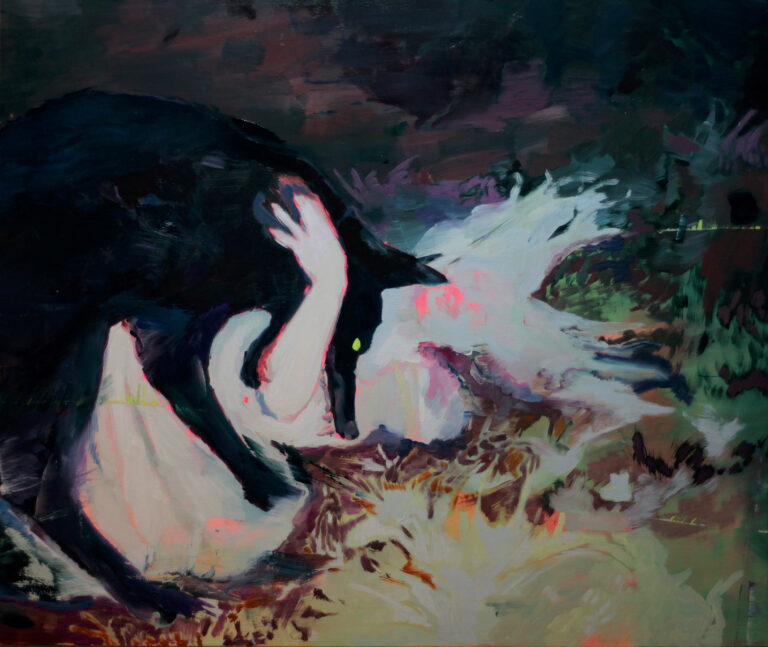
![Fundo [Background]](https://www.vervegaleria.com/wp-content/uploads/2022/05/220217_verve_010-copy-768x1059.jpg)
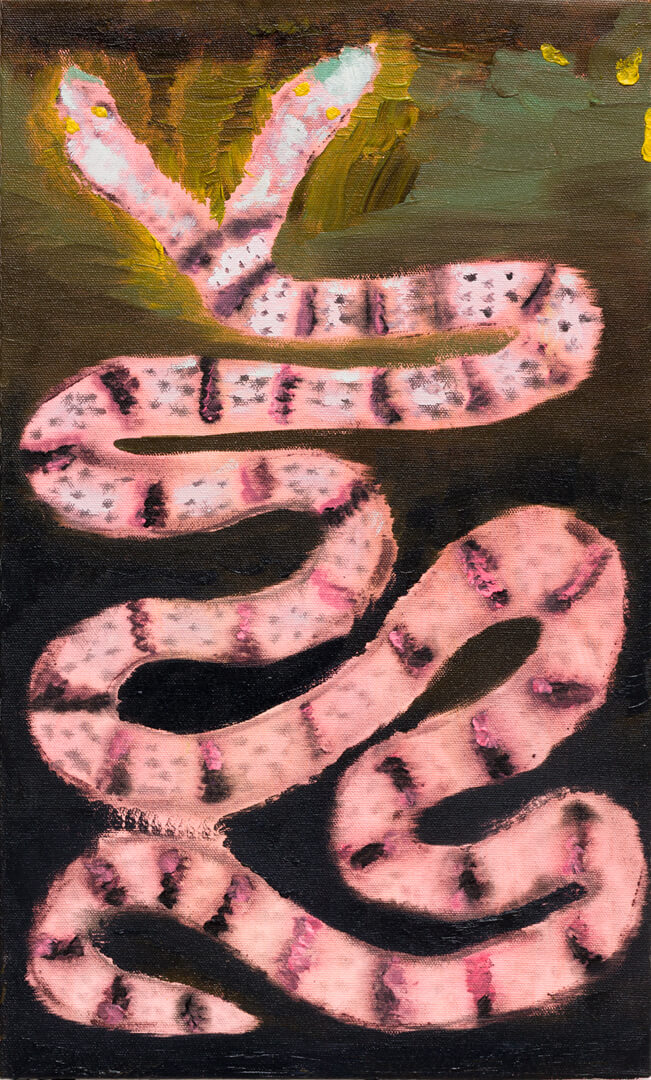
![Cobra levitando [Levitating snake]](https://www.vervegaleria.com/wp-content/uploads/2022/05/cobra-768x529.jpg)
![Pintura para imagem rupestre 0 - Acontece ao anoitecer [Rock painting 0 - Happens at dusk]](https://www.vervegaleria.com/wp-content/uploads/2022/05/imagem-0-768x378.jpg)
![Aparição (eu preciso saber interpretar os sinais) #1 [Apparition (I need to know how to interpret the signs) #1]](https://www.vervegaleria.com/wp-content/uploads/2022/05/aparicao-1-180-dpi-768x1155.jpg)
![Aparição (eu preciso saber interpretar os sinais) #2 [Apparition (I need to know how to interpret the signs) #2]](https://www.vervegaleria.com/wp-content/uploads/2022/05/aparicao-2-180-dpi-768x1165.jpg)
![Pintura para imagem rupestre (caça) - Moby Dick ou o Leviatã [Painting for rock image (hunting) - Moby Dick or the Leviathan]](https://www.vervegaleria.com/wp-content/uploads/2022/05/leviathan-moby-dick-768x667.jpg)
![Pintura para secador de garrafas do Duchamp [Duchamp bottle dryer paint]](https://www.vervegaleria.com/wp-content/uploads/2022/05/duchamo.jpg)
![Pintura para aparição IV - O santo guerreiro contra o dragão da maldade [Painting for Appearance IV - The Holy Warrior against the Dragon of Evil]](https://www.vervegaleria.com/wp-content/uploads/2022/05/o-santo-guerreiro-contra-o-drag∆o-da-maldade-3-300dpi-768x922.jpg)
![Pintura para aparição III - O santo guerreiro contra o dragão da maldade [Painting for Appearance III - The Holy Warrior Against the Dragon of Evil]](https://www.vervegaleria.com/wp-content/uploads/2022/05/o-santo-guerreiro-contra-o-drag∆o-da-maldade-2-300dpi-768x960.jpg)
![Pintura para imagem rupestre (sexo) - Vênus helênica sobre fotografia de editorial [Painting for rock image (sex) - Hellenic Venus on editorial photography]](https://www.vervegaleria.com/wp-content/uploads/2022/05/venus-768x913.jpg)
